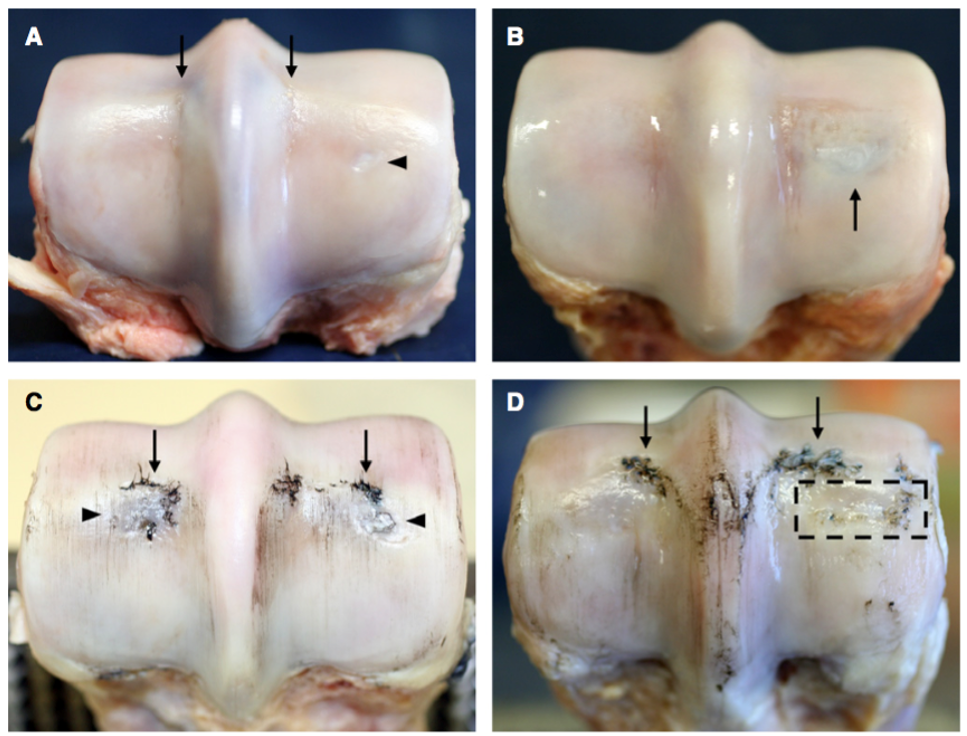
Introduction
If you think about it, the equine joint is pretty amazing. The joint must tolerate these extreme forces without pain or failure. Unfortunately, osteoarthritis is an extremely common career limiting health issue. Due to this, equine joint supplements are extremely popular. Prior to discussing the supplement ingredients in detail, understanding some of the basic physiological processes is key.
Firstly, osteoarthritis has no cure, and in older performance horses is almost inevitable. Therefore, prevention and management of clinical signs is the best we can currently do. This is due to the nature of cartilage. The cells in cartilage do not divide well, and therefore, it doesn’t repair well. In addition to this fact, cartilage does not have its own blood supply so that adds to the hindrance of repair. A second key point that should be mentioned is that not all inflammation is bad!! Inflammation is an important physiological mechanism for the body to return to homeostasis.
Let’s Look at Some Neat Visual Examples!!
Sometimes, it can be difficult to visualize what is being discussed when it comes to joint health because it is not something horse owners can see. This study evaluated the joint health of 16 thoroughbreds who had racing careers.
Image A and B are both younger horses and images C and D are older. In image A, the cartilage surface is still intact. In image B, there is a slightly darkened region, but the cartilage is still intact. As we move into C and D the cartilage is no longer intact. Image C shows wear lines, significant cartilage disruption and darkening beneath the cartilage. In image D, there is a further cartilage disruption and the joint surface is noticeably sunken in. Below the image is a table summarizing the horse characteristics.


Defining the Compounds
Chondrotin Sulfate is a structural component of cartilage and the extracellular matrix. A key role of this compound is to provide resistance to compression. Chondrotin sulfate has been tested both in vivo and in vitro. However, there are inconclusive results, this is hypothesized to be a result of poor bioavailability.
MSM is short for methylsulfonylmethane. This compound is a metabolically available form of sulfur. This is important when discussing joint health as both collagen and glucosamine require sulfur. These tissues are generally found within cartilage. The research on MSM is consistent in showing positive results.
Glucosamine is a compound found in cartilage that contributes to maintaining shock absorption and flexibility. Similar to chondroitin sulfate, we really don’t have conclusive evidence on glucosamine supplementation. The general theme in the research, is that when glucosamine is supplemented on its own there is low efficacy.
Hyaluronic Acid is a component of a variety of tissues that are important to joint health such as cartilage, and connective tissue. Hyaluronic acid is commonly either injected or given orally, and both methods have been shown to produce positive results.
Recent Study Spotlight
While doing the research for this blog post, I came across an interesting and relatively recent study. This study gave oral supplementation of chondroitin sulfate and glucosamine to horses and evaluated many different parameters. Now, in the commercial supplements, these two compounds are generally provided in combination. Therefore, this was a particularly interesting paper. Here is the citation if you’re interested in reading it: Yamada, A. L. M., do Prado Vendruscolo, C., Marsiglia, M. F., Sotelo, E. D. P., Agreste, F. R., Seidel, S. R. T., … & da Silva, L. C. L. C. (2022). Effects of oral treatment with chondroitin sulfate and glucosamine in an experimental model of metacarpophalangeal osteoarthritis in horses. BMC Veterinary Research, 18(1), 1-14.
Their reasoning for the mechanisms behind the combined supplementation is that the chondroitin sulfate is effective for controlling pain responses and the glucosamine stimulates glycosaminoglycan synthesis which reduces degradation in the extracellular matrix. The authors had a treatment group with the joint supplementation and a control group that received neither of the compounds. It was concluded that the supplementation was effective with improvement shown in joint flexion angle, lameness analysis, synovial concentrations of the biomarker PEG2 and ultrasonographic examination. Unfortunately, like many in vivo equine studies, a small sample size of only 16 horses was used. Therefore, evaluating supplements with larger sample sizes would be ideal as research moves forward.
Concept Overview
In a recent webinar I attended through Rutgers University, there were presentations from some of the top equine researchers on a variety of supplement topics. One of the presentations was specifically on joint supplements and that professor discussed work their lab had done on individual supplements. What piqued my interest, was that the commercial supplements discussed had similar ingredients but achieved differing benefits. The one supplement was a glucosamine/chondroitin sulfate combination and there was improvements in the cartilage structure. Whereas another commercial supplement this lab evaluated that supplemented glucosamine and chondroitin sulfate as well showed an improvement in pain but not in cartilage structure.
These professionals challenged horse owners to use their purchasing power to vote for research. Often, if you simply look at a supplement companies’ website, they will have their research featured (if they have actually had research done!), and if you can’t find it online a simple email can get you the answers you’re looking for.
To conclude, research tells us that there are benefits to some of these ingredients, but we do not definitively know what combinations of the popular ingredients and what dosage amounts are ideal to optimally support our horses.
By: Madeline Boast, MSc. Equine Nutrition
References
Frisbie, D. D., McIlwraith, C. W., Kawcak, C. E., & Werpy, N. M. (2016). Efficacy of intravenous administration of hyaluronan, sodium chondroitin sulfate, and N-acetyl-D-glucosamine for prevention or treatment of osteoarthritis in horses. American Journal of Veterinary Research, 77(10), 1064-1070.
Frisbie, D. D., McIlwraith, C. W., Kawcak, C. E., & Werpy, N. M. (2016). Efficacy of intravenous administration of hyaluronan, sodium chondroitin sulfate, and N-acetyl-D-glucosamine for prevention or treatment of osteoarthritis in horses. American Journal of Veterinary Research, 77(10), 1064-1070.
Oke, S. L., McIlwraith, C. W., & Moyer, W. (2010, December). Review of the economic impact of osteoarthritis and oral joint-health supplements in horses. In Proc Am Assoc Equine Pract (Vol. 56, pp. 12-16).
Pearson, W., & Lindinger, M. (2009). Low quality of evidence for glucosamine‐based nutraceuticals in equine joint disease: review of in vivo studies. Equine Veterinary Journal, 41(7), 706-712.
Pearson, W., Orth, M. W., Karrow, N. A., MacLusky, N. J., & Lindinger, M. I. (2007). Anti‐inflammatory and chondroprotective effects of nutraceuticals from Sasha’s Blend in a cartilage explant model of inflammation. Molecular nutrition & food research, 51(8), 1020-1030.
Trumble, T. N. (2005). The use of nutraceuticals for osteoarthritis in horses. Veterinary Clinics: Equine Practice, 21(3), 575-597.
Turley, S. M., Thambyah, A., Riggs, C. M., Firth, E. C., & Broom, N. D. (2014). Microstructural changes in cartilage and bone related to repetitive overloading in an equine athlete model. Journal of anatomy, 224(6), 647-658.
Yamada, A. L. M., do Prado Vendruscolo, C., Marsiglia, M. F., Sotelo, E. D. P., Agreste, F. R., Seidel, S. R. T., … & da Silva, L. C. L. C. (2022). Effects of oral treatment with chondroitin sulfate and glucosamine in an experimental model of metacarpophalangeal osteoarthritis in horses. BMC Veterinary Research, 18(1), 1-14.